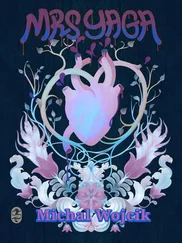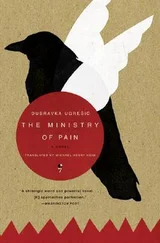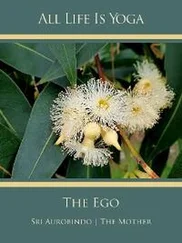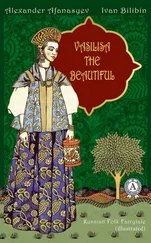Vasorru babais an old woman with an iron nose almost reaching her knees, who lives in Hungarian folktales. Vasorru baba tests young heroes and heroines, and if they aren’t kind to her, she turns them into animals or stones.
The Ragana is a mythical Lithuanian evil-doer ( regeti is Lithuanian for to know, to see, to predict; ragas means horn or crescent moon). The Ragana has a mortar that she sleeps in or flies in, propelling herself with a broom and pestle. In winter, the Raganas swim in the open air, amid the ice, and sit high in the birch-trees combing their long hair. Their evil nature is more obvious in summer, when they destroy the crops, curdle the milk, kill newborn babes and make trouble at weddings, where they have been known to turn the groom into a wolf. The Ragana is connected with death and resurrection, or rather regeneration.
The Polish Jendžibaba, or Jedsi baba, is a woman who trots along on hen’s feet ( pani na kurzej stopce ), and she shares all the general characteristics of the Russian Baba Yaga.
The Lusatian Sorbs [55]believe in the wurlawy(or worawy ), women of the forest who emerge from the trees at precisely ten o’clock in the evening. They set about ploughing the fields, and as they plough, they make a great hubbub. Wjeraor Wjerobabais the Lusatian Sorb version of Baba Yaga.
An old woman with an iron nose ( Zhaliznonosa baba) ambles through Ukrainian fairytales, legends and creeds. She is followed by thirty babas with iron tongues and an iron baba (Zhalizna baba) whose house stands on duck’s feet.
The Norwegian variant of Baba Yaga could have been assembled from three women who appear in Norwegian fairytales. One is an old woman, the ‘old mother’ ( gamlemor), whose long nose gets wedged into a tree stump and stays wedged there for a hundred years or so. The hero Espen Askeladd (a Norwegian version of the Russian Ivan the Fool or Ivan Popjalov) helps the old woman to free her nose, and in return he is given a magic flute. The second is the trollkjerringor haugkjerring, an old witch, while the third is the kjerringa mot strommen(roughly, ‘the woman who goes against the stream’), a stubborn woman, a contrary character, even a shrew.
Finno-Karelian folklore has the Syoyatar. Sparrows fly out of her eyes, crows fly out of her toes, vipers slither from under her fingernails, ravens flap out of her mouth and magpies out of her hair. The Syoyatar embodies evil and never helps anybody, but it is a comfort to know that she is no cannibal. Akka, another Finno-Karelian evil-doer, is much closer to Baba Yaga. She lives in the woods or near the seashore, she threatens to eat passing travellers, she has breasts the size of buckets and she can wrap her legs three times around the hut. Like Baba Yaga, Akka wants the hero or heroine to accomplish different tasks (heating the bath, feeding the animals, caring for the horses), and she rewards good service with useful advice.
Baba Yaga has numerous relatives in Western Europe. Let’s just mention that in France – the land of foie gras – there are legendary females with goose feet. Arie, or Aunt Arie ( Tante Arie, Tantarie) has iron teeth and goose feet. Tantarie punishes lazy weavers and rewards hard-working ones. During the Christmas holiday, she appears on a donkey and hands out presents. Tantarie lives in the cave where she guards her chest with its jewels, and she only takes off her golden crown, studded with diamonds, when she bathes. In Germany, Perchta is an old woman with big goose feet, who carries her broom around with her, as well as a needle and scissors. She cuts open the stomachs of lazy girls and sloppy housewives with her scissors and fills them up with rubbish. The famous Frau Holle – a tall, grey-haired woman with long teeth, who frightens little children and tests the kindness and patience of young maidens – has features in common with Baba Yaga.
* * *
Turks, Tartars, Bashkirs, Uzbeks, Chuvash, Turkmen, Kirghiz, Azerbaijanis, Kumyks, Nogais and many other peoples believe in the Alabasti.The Alabasti is demonically evil, a hideous woman with dangling breasts, chaotic hair and a talent for metamorphosis. She has bird’s legs (or so they believe in Azerbaijan), or even hooves (according to the Kazakhs). The Tartars of Kazan believe that Alabasti has a single eye in the middle of her forehead, and a stone nose. She has no flesh or skin on her back, so her internal organs are exposed for all to see, and she has sharp talons instead of fingers and toes. In Kirghizia, they believe in two Alabastis: the very evil black one ( kara ) and the less dangerous blonde one ( sari ). Alabasti is never without her magic book, comb and money. In the picturesque legends of the Chuvash, Alabasti is a voluptuary who keeps company with hunters, brings them luck, gives them her own milk to drink and feeds them with her own flesh that she slices from her ribs. Alabasti can be tamed by stealing a hair from her head or her precious possessions: the comb, book and money. The Turks believed that Alabasti becomes good and docile if you pass a needle through her clothes. Alabasti brings illness and nightmares, she drinks her victims’ blood and she is especially dangerous to women in childbed and to newborn babes. Alabasti loves horses, and she rides them by night. Her origins are by no means clear. Some suppose that she is Turkish, and others, Iranian. Al may be the name of an ancient deity, close to ilu (among Semitic tribes), while the Indo-European basti means spirit or deity. Alabasti’s k66ith and kin are scattered among many peoples, and their names are al pab, ali, ol, ala zhen, hal, alk, ali, almazi, almas, kara-kura, shurale, su anasi, vutash.Baba Yaga is her Slavic sister.
All in all, it is not hard to conclude from this quick survey that Baba Yaga straddles the globe: the ‘baba genus’ is international, and Baba Yaga’s kinsfolk can be found in Asia, South America and Africa; ‘Baba Yaga’s International’ is making trouble here, there and everywhere, as it has always done. [56]
* * *
This impressive, grandiose mythic transmission has been going on for centuries. The ‘old crones’ International’ – all those monstrosities, malefactors, frights, freaks and demons, those ‘scum of the earth’, those ‘prisoners of want’ – is united by the fact of female gender. Ancient (and other) myths diffused around the world, getting contaminated by Christianity and Christian myths, as well as local pre-Christian, folkloric and mythico-ritual creeds. And all that long-lived, labyrinthine, fertile, profoundly misogynistic but also cathartic work of the imagination gave birth to Baba Yaga.
AND HERE, MY FRIEND, COMES THE STORY’S END
It seems, dear editor, that the moment has come for us to part. I hope the sudden change of tone won’t confuse you: we have sped through several thousand signs together; we have pecked at grains of language side by side; they say that reading should be interactive, just like making love, so the assumption is that we have not remained total strangers to each other. Human rituals require that we stay together for a little longer and share a prohibited postcoital cigarette.
I’m sure you won’t mind admitting that there was too much of everything. In fact, you were afraid at one point that I would never stop. In some places you sighed with boredom, in others you yawned, in others again your forehead creased in a frown. You had fiendish folklore coming out of your ears. You were given an overdose, I know. At first you felt as if somebody had shut you in a box. It was cosy enough – mummy’s tummy, an improvised cottage, a bit of unthreatening darkness: they all stir the childish imagination. And then you felt cramped, and more cramped, until you almost couldn’t breathe. In a well-made text, the reader should feel like a mouse in cheese. And that’s not how you felt at all, is it?
Читать дальше












